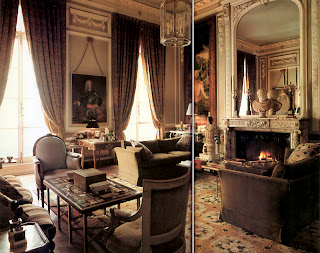"Go figure," said the Celt, spotting, as had I, my least favorite food on the prix fixe menu. It had been there, too, seventeen years ago and despite the passing of the years I have grown no fonder of dead bird.
"Quite." I said resignedly, "You'll be helping me with that. I sometimes wonder how dead bird got to be the culinary equivalent of the pansies of the landscaping world?
"Not that there's anything wrong with that," he said, ignoring my sourness about the menu, "some of our best friends are ... "
"Landscapers?"
"Pansies," he said, causing any residual gloom about the impending grilled duck breast and crépinette with braised new garlic, potatoes fried in duck fat, and garden salad, to dissolve in his smile.
"Too many damned adjectives," I growled as I continued to read the menu "and who in their right minds says gâteau glacé instead of ice-cream?" Mumble, grumble, mumble.
"All right, Grumbleweed, relax," he said. So I did.
What seemed extraordinary all those years ago now seemed quite the opposite. It occurred to me that though there must have been changes at what had been my long-admired highpoint in American cooking, it was I who have changed. I live in a city where restaurant food can be superb, and visit other cities of which the same can be said. Nonetheless, disappointed we were not – a little let down, perhaps, despite standards having remained high – rather that the restaurant was no longer the stand-out it once was. For the world had changed around it, and that change for the better had been initiated by the owner and founder of the restaurant.
San Francisco, a city I had heretofore not liked much, came alive for me last weekend. The city hadn't changed, I thought, so the difference was me. Perhaps I had mellowed, though a snort from the Celt put paid to that concept pretty quickly.
Our trip to San Francisco was to see The Cult of Beauty: The Victorian Avant-Garde 1860 – 1900 an exhibition we'd missed in London last summer. And I can tell you it was well worth the journey, especially for an interior designer with any pretensions to knowing the history of styles and, if one thought it had relevance to one's life, to knowing something more about gay history by reading about the Aesthetic Movement.
The Fashion World of Jean-Paul Gaultier: From the Sidewalk to the Catwalk at the de Young museum made the flight across the country doubly worth it. Matching, it seems to me, the endless inventiveness of Jean-Paul Gaultier are what appear to be automata amongst the mannequins. What they are, in fact, are mannequins with basic but blank facial features onto which are projected videos of moving faces that appear to interact with the beholder – sometimes looking directly at one; sometimes smiling derisively; occasionally a quick glance and a "bravo" such as I received when I stepped in front of the matelot and took out my iPhone; from others monologues, and in one case whistling and singing. Disconcerting and thrilling at the same time – I had not had such a good time in a museum in years.
You can't go back to the same place, as the saying goes – by which I think is meant you can't go back to the same time and place. But this trip showed me that, sometimes, you can go back and see the same place in a new light. It has changed, and I have changed, and both, I like to think, for the better.




























.JPG)













